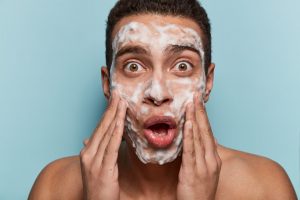Ah, spring: the season of blooming flowers and trees, new birth, sunshine, butterflies and, of course, the dreaded pollen. In fact, just thinking about pollen is making me itch.
While the season may bring joy and excitement to most, for some it can be an anxious time – one that’s associated with dreaded allergies, including those that crop up on your skin.
According to the Better Health Channel, “An allergy occurs when the body overreacts to an allergen or ‘trigger’ that is typically harmless to most people”, with allergies including “hay fever, asthma, eczema, hives and food allergy”.
Allergies often involve an inflammatory response with symptoms, says to the Better Health Channel, ranging from “swelling of the lips, face, eyes and tongue, sneezing, red and itchy eyes, headache, skin rash” and more.
“If we look at our skin as a manifestation of what’s happening from an inflammatory perspective, anything that causes inflammation can potentially be reflected in our skin and how it appears and how it feels,” says community pharmacist and master herbalist Gerald Quigley.
He adds that with a rise in pollen count as the weather transitions from winter to spring if this leads to an inflammatory response in someone who is allergic to pollen, the result may be “red, angry skin, which can become dry and itchy”.
Interestingly, Mr Quigley points out, while people commonly associated pollen allergies with red, watery, itchy eyes, wheezing and sneezing, many may not “relate what they feel on [their] skin with what’s happening elsewhere”.
In some people, says dermatologist Dr Melissa Manahan, seasonal pollen may lead to a flare-up in atopic dermatitis, particularly “if that person also has a concomitant allergy”.
She adds that the rise in temperature may also be problematic for some people, while “for others, [skin issues] may improve with an increase in humidity”.
“People may notice a seasonal pattern from year to year, which is predictable,” she says in response to how allergic skin conditions differ from other, more chronic conditions.
“If [skin issues are] associated with an airborne allergy, it commonly manifests with dermatitis on exposed areas, particularly eyelids (the thinnest skin on the body), face, neck and forearms.”
Dr Manahan also points to other skin conditions that may occur as the weather warms up and the skin is exposed to the sun after a period of limited sun exposure in winter.
These, she says, are referred to as “polymorphic light eruption [and] juvenile spring eruption” and “result in an itchy rash particularly on the limbs, upper chest and tips of the ears – juvenile spring eruption”.
“These are not associated with seasonal allergies,” says Dr Manahan.
“These are sun-related conditions that tend to occur in predisposed individuals who spend a few hours in the sun in spring and don’t receive much sun in winter. A common scenario would be a traveller from a southern state who travels to Queensland for a spring holiday.”
Managing skin in spring
While a flare-up of atopic dermatitis is typically “managed as per a typical atopic dermatitis flare” according to Dr Manahan, she also points to the “possible added benefit of an antihistamine” to help manage the skin issue.
She adds that “avoiding triggers” is also ideal, but this “can be difficult if the allergens are airborne pollens”.
To help manage allergic skin conditions, she also suggests using a “soap-free wash” and moisturising regularly with a “fragrance-free” moisturiser.
“I prefer plain petroleum jelly, or white soft paraffin/liquid paraffin combination on eyelids as this is a very sensitive site,” says Dr Manahan, suggesting consideration of topical steroids if the condition is more severe – but only “under medical supervision, if required on the face”.
For those with polymorphic light eruption or juvenile spring eruption, she suggests the following strategies:
- “Photoprotection with appropriate clothing, sunscreen and sun avoidance.
- “Sometimes prescription medications are used to control the itch and to prevent it if it occurs yearly. Sometimes dermatologist-supervised phototherapy is used.
- “If the itch is mild, then antihistamines and topic steroids may be helpful.”
However, Dr Manahan underscores that if the skin issue is suspected to be polymorphic eruption or juvenile spring eruption, and if it’s “not relieved with OTC products, then it’s important to see a doctor, as more serious photosensitive conditions can present similarly”.
The pharmacy assistant’s role
Skin conditions and triggers that lead to flare-ups can be tricky and frustrating to manage, and one of the most important roles of a pharmacy assistant in this space, according to Mr Quigley, is in taking a “detailed history” from the customer.
“So … not just looking at what’s presented, but a detailed history as to how long the situation has been there, what’s worked before and what hasn’t, what the person cleanses with, what they moisturise with and how often they moisturise,” he says.
“These are all questions that are fairly elementary in trying to find a solution to what’s presented in front of you. You can just say, ‘Give me a bit of background so we can sort this out for you’. All these things rely on effective communication.”
Mr Quigley also stresses the importance of getting the pharmacist involved, particularly if it’s a skin issue “that hasn’t responded in the past to various treatments”.
Dr Manahan adds that “if the problem is not under control with regular moisturiser and a soap-free wash, if it’s affecting sleep, if there’s a concern for concomitant infection – for example, open wounds, yellow crust”, then it’s important that the pharmacist is involved in the management of the customer, and/or that the customer sees a GP.
To read the full feature as it appears in the September issue of Retail Pharmacy Assistants e-magazine, visit: rpassistants.com.au/magazines/retail-pharmacy-assistants-september-2021/







